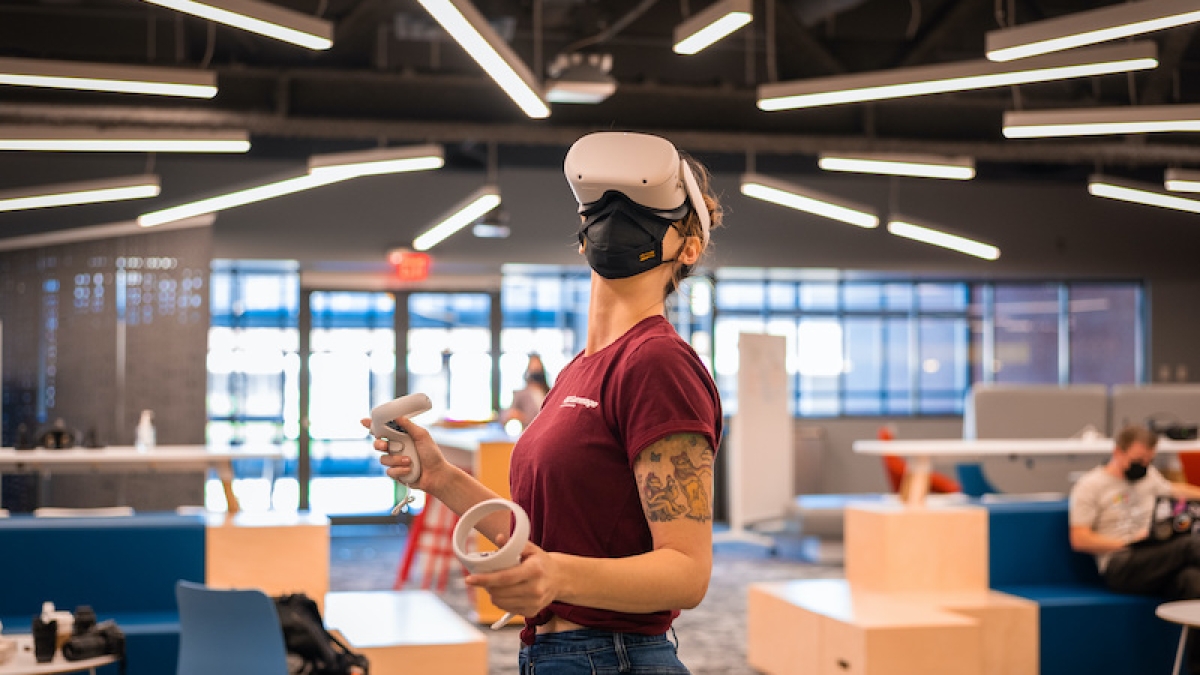ASU and Verizon partner to bring 5G — the next-generation of wireless technology — to the university

“We are in the most transformative technological moment since the early stages of the Industrial Revolution,” ASU President Michael Crow said during a welcome keynote at the 2022 Smart Region Summit last week. Crow, who was joined by CEO of Verizon Business Tami Erwin, shared how partnerships are key to fueling the innovation happening across the university, especially when it comes to digital transformation.
Together, Crow and Erwin announced the next phase in the ASU and Verizon partnership to bring Verizon’s 5G Ultra Wideband to the university.
Providing ultra-fast connectivity, 5G Ultra Wideband is poised to help the university move forward initiatives and services that will ultimately improve access to the most advanced immersive learning experiences, expand research opportunities and increase more equitable health care — all of which are taking place at ASU.
Under the partnership, ASU has become the location of Verizon’s newest 5G Innovation Hub. Housed within the university's Learning Futures Collaboratory in the Creativity Commons on Tempe’s campus, the hub powers the space with Verizon’s 5G Ultra Wideband network.
ASU Chief Information Officer Lev Gonick explained that while 5G has been available from a variety of carriers across campus, the innovation hub offers Verizon 5G Ultra Wideband indoors. Verizon 5G Ultra Wideband offers extremely fast internet speeds through increased bandwidth — the more bandwidth, the more data can be sent (think uploading from your computer) and received (think downloading to your computer) — as well as low latency, which offers the lowest minimal delay (think seamless streaming).
For example, both increased bandwidth and low latency can significantly improve the streaming of data to create immersive experiences that more closely mimic real-world interactions.
“These technologies that leverage broadband at the fastest speeds and most advanced level imaginable allow us to create an environment in which the person, the learner, becomes emotionally connected in the story around the learning process itself,” Crow said. “... At ASU, we’ve become, with this next phase of our partnership with Verizon, the furthest at the tip of the spear to be empowered with 5G technology and continue to improve the ways in which we learn, work and live.”
At the summit, Crow and Erwin spoke about the digital transformations being led by their respective organizations. With the event’s emphasis on closing the digital divide, both leaders shared how the two organizations can work together to bolster equity across a region by expanding the reach and creative uses of services and tools — like high-speed broadband and 5G.
In closing, Erwin and Crow shared that one of the first programs to launch out of the space will be a digital equity jam for ASU students, sponsored by Verizon, Amazon Web Services and Inseego. Kicking off in early February 2022, the jam invites student-led teams to develop use cases showcasing how Verizon 5G Ultra Wideband and mobile edge computing can be used to help bridge the digital divide. Focus areas will include health, climate, poverty, human rights and education. The winning team will receive project seed funding, access to the Clinton Global Initiative 2022 curriculum and the opportunity to pitch their venture to the Clinton Global Initiative in fall 2022.
Registration for the ASU and Verizon 5G Student Jam is now open; ASU students of all disciplines are invited to participate.
“Working with ASU, we have an extraordinary opportunity to research and develop new 5G-enabled experiences that can improve remote learning and help bridge the digital divide,” Erwin said. “Verizon 5G Ultra Wideband’s super-fast speeds, increased bandwidth and low latency can enhance applications ranging from immersive education to connected communities. By collaborating with ASU’s researchers, we hope to accelerate the innovation process and develop technology that will harness the full potential of 5G and edge compute.”
For more information, check out recent coverage of the Verizon 5G Innovation Hub at ASU in Fierce Wireless:
More Science and technology

ASU postdoctoral researcher leads initiative to support graduate student mental health
Olivia Davis had firsthand experience with anxiety and OCD before she entered grad school. Then, during the pandemic and as a result of the growing pressures of the graduate school environment, she…

ASU graduate student researching interplay between family dynamics, ADHD
The symptoms of attention deficit hyperactivity disorder (ADHD) — which include daydreaming, making careless mistakes or taking risks, having a hard time resisting temptation, difficulty getting…

Will this antibiotic work? ASU scientists develop rapid bacterial tests
Bacteria multiply at an astonishing rate, sometimes doubling in number in under four minutes. Imagine a doctor faced with a patient showing severe signs of infection. As they sift through test…